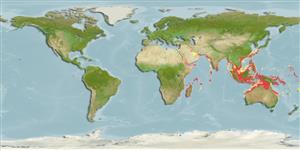Common names from other countries
Classification / Names / Names
Common names | Synonyms | Catalog of Fishes (gen., sp.) | ITIS | CoL | WoRMS
Environment: milieu / climate zone / depth range / distribution range
Ecology
Benthic; depth range 0 - 100 m (Ref. 99185). Tropical; 35°N - 28°S, 32°E - 134°W
Indo-West Pacific: East African waters to the Red Sea Taiwan. One of the most common squillids in the western part of its distribution range.
Length at first maturity / Size / Weight / Age
Maturity: Lm ? range ? - ? cm Max length : 17.0 cm TL male/unsexed; (Ref. 92)
A very common shore species that burrows in level-bottom habitats (Ref. 92). Prefers sandy-muddy bottoms (Ref. 87055). May deposit feed as well (Ref. 105093).
Life cycle and mating behavior
Maturity | Reproduction | Spawning | Eggs | Fecundity | Larvae
Some members of the order Stomatopoda pair for life and some come together only to mate. Males produce sperm ducts rather than spermatophores; females can brood a maximum of 50,000 eggs. Life cycle: Eggs hatch to a planktonic zoea which lasts for 3 months.
Manning, R.B. 1998. (Ref. 92)
IUCN Red List Status (Ref. 130435)
CITES status (Ref. 108899)
Not Evaluated
Not Evaluated
Threat to humans
Harmless
Human uses
| FishSource |
Tools
Internet sources
Estimates based on models
Preferred temperature
(Ref.
115969): 24.7 - 29.1, mean 28.1 (based on 2180 cells).
Resilience
High, minimum population doubling time less than 15 months (K=4.44-6.6).
Vulnerability
Low vulnerability (10 of 100).
